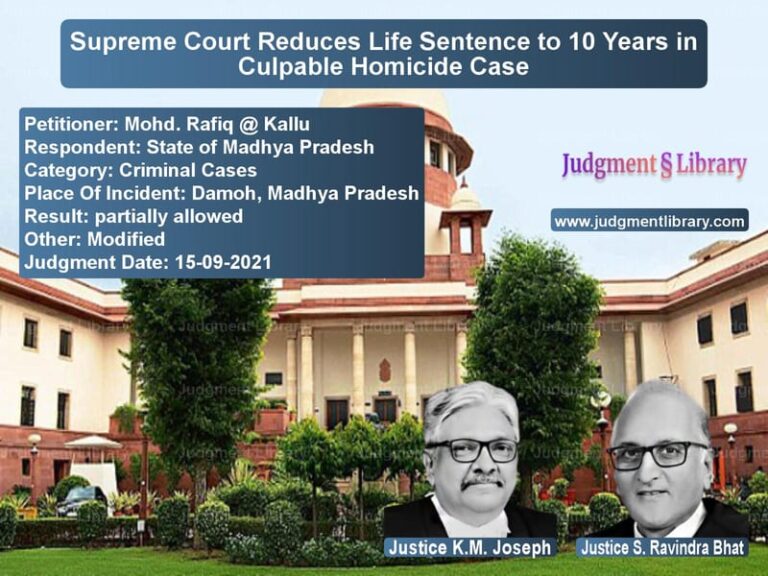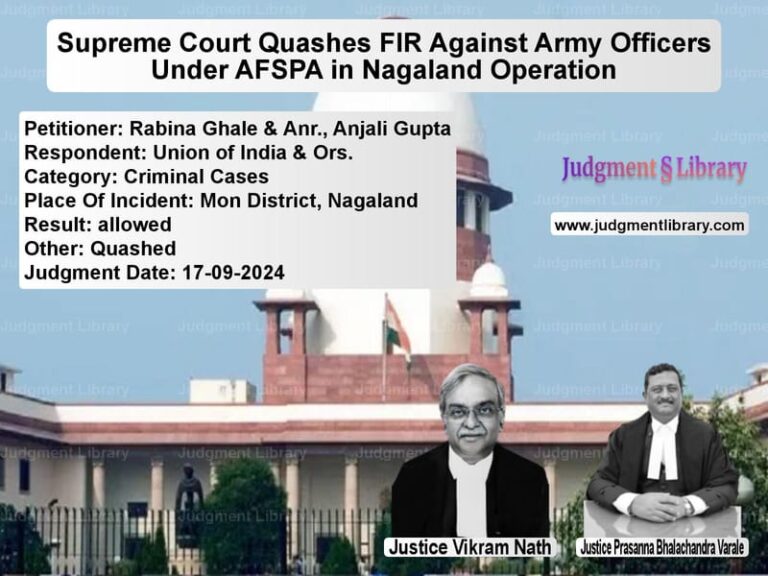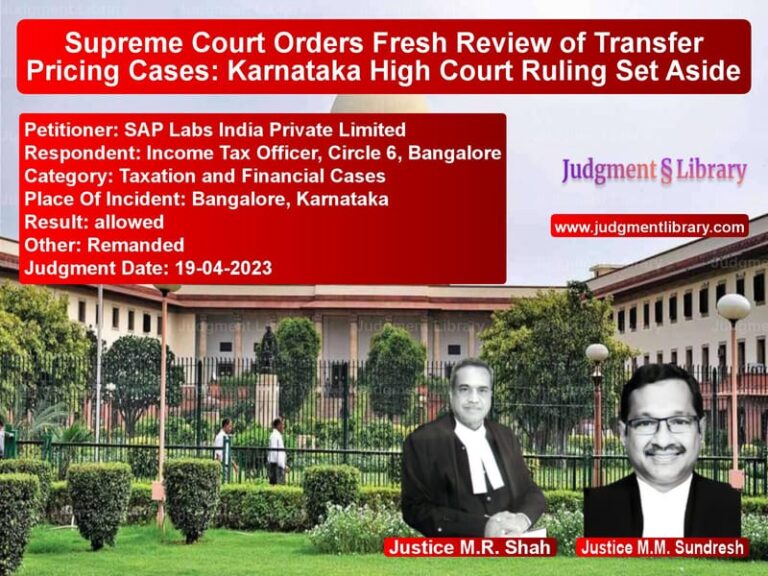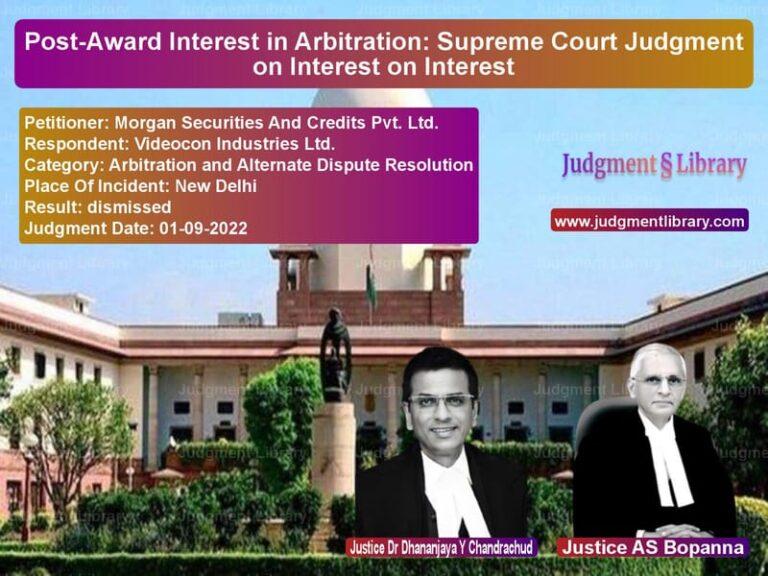Supreme Court Orders Debt Waiver for Small Farmers Under Agricultural Debt Relief Scheme
The case of Satpal & Anr. vs. Bank of India & Ors. revolves around the interpretation of the Agricultural Debt Waiver and Debt Relief Scheme, 2008. The Supreme Court had to decide whether the petitioners, who took an agricultural loan, were entitled to a full waiver under the scheme. The case raised critical issues on the classification of farmers and the application of debt relief policies.
Background of the Case
In 2008, the Indian government introduced the Agricultural Debt Waiver and Debt Relief Scheme to help farmers struggling with loan repayments. The scheme classified farmers into three categories:
- Marginal farmers (owning up to 2.5 acres)
- Small farmers (owning between 2.5 and 5 acres)
- Other farmers (owning more than 5 acres)
Under Clause 5 of the scheme, marginal and small farmers were eligible for a full waiver, whereas other farmers were entitled to only 25% relief.
The appellants, two brothers, took a loan of Rs. 3 lakhs from the Bank of India to purchase a tractor. They argued that they should qualify as ‘small farmers’ and be entitled to a full waiver. However, the bank classified them as ‘other farmers,’ limiting their relief to 25%.
Decisions by Consumer Dispute Forums
The appellants approached the District Consumer Disputes Redressal Forum, which ruled in their favor, concluding that:
- Each brother owned land separately, measuring 38 kanals 11 marlas (4.6 acres).
- Since neither owned more than 5 acres individually, both should be categorized as small farmers.
- The bank must waive the entire outstanding loan amount.
The State Consumer Disputes Redressal Commission upheld this decision.
Reversal by National Consumer Disputes Redressal Commission (NCDRC)
On appeal, the NCDRC overturned the ruling, stating that:
- The appellants’ land was in Faridabad, Haryana, which was not listed under Annexure-I of the scheme.
- The scheme’s benefits were applicable only in designated districts.
- The appellants were not eligible for a full waiver.
Arguments by the Appellants
The appellants challenged the NCDRC’s ruling before the Supreme Court, arguing:
- The classification of farmers is based on individual landholding, not the location of the land.
- Annexure-I applied only to ‘other farmers’ seeking partial relief, not to small farmers eligible for a full waiver.
- The government’s guidelines clearly stated that if a loan was jointly taken, the size of the largest holding in the pool should be considered, which in their case was within the small farmer limit.
Arguments by the Bank of India
The bank defended its decision, asserting:
- The appellants jointly mortgaged their land, which exceeded 5 acres, making them ineligible for full waiver.
- The NCDRC rightly interpreted Annexure-I in the context of all farmers under the scheme.
- The petitioners were classified as ‘other farmers’ because they availed investment credit for allied activities.
Supreme Court’s Observations
1. Farmers’ Classification Under the Scheme
The Supreme Court examined the scheme’s definitions and found that ‘small farmers’ are those cultivating land of up to 5 acres.
“The classification of eligible farmers should be based on individual landholding unless the loan is taken jointly. In such cases, the size of the largest landholding in the pool should determine the category.”
2. Relevance of Annexure-I
The Court held that the NCDRC had wrongly applied Annexure-I, which was only relevant for ‘other farmers’ seeking partial relief.
“The appellants sought a waiver under Clause 5, not Clause 6. Annexure-I restrictions do not apply to small farmers eligible for a full waiver.”
3. Legality of the District Forum’s Decision
The Court reaffirmed the findings of the District Forum and the State Commission, stating:
- The appellants’ landholding was correctly assessed at 4.6 acres.
- They fell within the small farmer category and were entitled to full loan waiver.
- The bank’s interpretation of the scheme was incorrect and deprived them of their rightful benefit.
Final Judgment
The Supreme Court ruled:
- The NCDRC’s decision was set aside.
- The ruling of the District Forum and State Commission was restored.
- The Bank of India was directed to waive the appellants’ outstanding loan amount.
- The appellants were awarded Rs. 50,000 as costs.
Implications of the Judgment
This ruling has significant implications for debt relief programs:
- Small farmers should not be denied benefits due to misinterpretation of policies.
- Banks must ensure accurate classification of farmers before rejecting loan waivers.
- Annexure-I applies only to partial relief claims, not to small and marginal farmers entitled to full waivers.
- Consumer forums can play a crucial role in securing farmers’ rights under government schemes.
Conclusion
The Supreme Court’s judgment reinforces the importance of ensuring that government welfare schemes are implemented correctly. The ruling ensures that small farmers receive the debt relief they are entitled to and prevents financial institutions from misinterpreting policies to deny benefits.
Petitioner Name: Satpal & Anr..Respondent Name: Bank of India & Ors..Judgment By: Justice D.Y. Chandrachud, Justice Hrishikesh Roy.Place Of Incident: Faridabad, Haryana.Judgment Date: 17-01-2020.
Don’t miss out on the full details! Download the complete judgment in PDF format below and gain valuable insights instantly!
Download Judgment: Satpal & Anr. vs Bank of India & Ors. Supreme Court of India Judgment Dated 17-01-2020.pdf
Direct Downlaod Judgment: Direct downlaod this Judgment
See all petitions in Debt Recovery
See all petitions in Damages and Compensation
See all petitions in Consumer Rights
See all petitions in Judgment by Dhananjaya Y Chandrachud
See all petitions in Judgment by Hrishikesh Roy
See all petitions in allowed
See all petitions in Quashed
See all petitions in supreme court of India judgments January 2020
See all petitions in 2020 judgments
See all posts in Civil Cases Category
See all allowed petitions in Civil Cases Category
See all Dismissed petitions in Civil Cases Category
See all partially allowed petitions in Civil Cases Category







